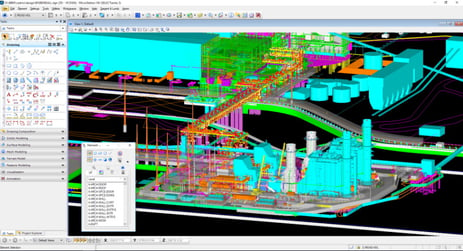Project
To meet a growing demand for electricity and to decrease pollution, Tampa Electric Company needed to replace a coal-fired unit at the Big Bend Power Station in Apollo Beach, Florida with a gas-fired combined-cycle unit. The repowering project, undertaken by Sargent & Lundy, includes installing two new generators, repurposing an existing steam turbine generator, adding new natural gas infrastructure, reworking the water system, and building transmission and interconnection facilities. Facing space constraints that would split the large, complex design across a 400-foot-wide seawater canal, Sargent & Lundy had to find a way to overcome the obstacles while maximizing productivity, reducing construction delays, optimizing the design, and maintaining the budget.
Solution
To meet the project’s challenges, Sargent & Lundy utilized a connected data environment, along with a building information modeling methodology and laser scans of the project site to develop a digital twin of the assets. Deploying 3D visualization applications allowed the project team to optimize various design elements, including piping, pipe racks, and flood walls to protect the facility from storm surges. After optimizing each of the 271 individual models, the project team integrated the models into the digital twin, ensuring that the equipment would fit within the tight infrastructure. The digital twin also allowed Sargent & Lundy to aid the installation contractor’s construction process, and the organization used a connected data environment to closely track materials, such as piping, needed during construction.

Image: Courtesy of Sargent & Lundy
Outcome
Visualization and data sharing within the digital twin helped the team collaborate 40% more efficiently than when using traditional methods. By optimizing designs within the digital twin, Sargent & Lundy reduced the amount of steel needed for the project by 350 tons, saving USD 2 million. Incorporating existing plant features into the digital twin improved design accuracy by 20% and halved the number of visits to the site. Moreover, the digital twin helped to develop a new construction schedule, which is expected to reduce rework, save hundreds of resource hours, and lower construction costs by USD 1.5 million.

Software
MicroStation formed the basis of the federated digital twin, bringing together 271 digital models from numerous disciplines and over 2,000 individual files. MicroStation also incorporated point-cloud data from laser scans of on-site assets, which were then enhanced with engineering components and as-built designs. OpenBuildings Designer and STAAD helped Sargent & Lundy design and evaluate piping and support structures, as well as reduce the number of welds needed on the galvanized steel. Additionally, STAAD helped design teams quickly complete structural and deflection analysis for new and existing structures. Lastly, OpenRoads Designer allowed the design teams to plot the design of the utility rack stretching over the seawater canal.
Watch the Project Summary
Facts
- The repowering project includes installing two new generators, modifying an existing steam generator, and natural gas infrastructure split across a 400-foot-wide canal.
- Visualization and data sharing within the digital twin helped the team collaborate 40% more efficiently than using traditional methods.
- By optimizing designs within the digital twin, Sargent & Lundy reduced the amount of steel needed for the project by 350 tons, saving USD 2 million.
- Incorporating existing plant features into the digital twin improved design accuracy by 20% and halved the number of visits to the site.
 "Innovating with digital twins is a game-changer that allowed our designers to align all the engineering data into a single source of truth so they can design with existing conditions and see the impact of changes immediately. Having this capability was invaluable, as it allowed our engineers to efficiently solve problems and be more confident in the impact of their designs..”
"Innovating with digital twins is a game-changer that allowed our designers to align all the engineering data into a single source of truth so they can design with existing conditions and see the impact of changes immediately. Having this capability was invaluable, as it allowed our engineers to efficiently solve problems and be more confident in the impact of their designs..”
Edward Hanko
Design Manager
Sargent & Lundy
